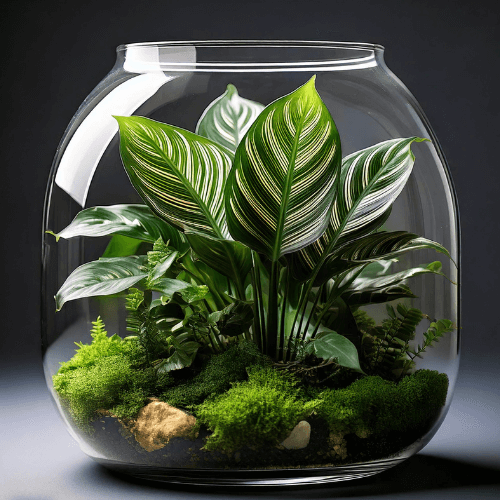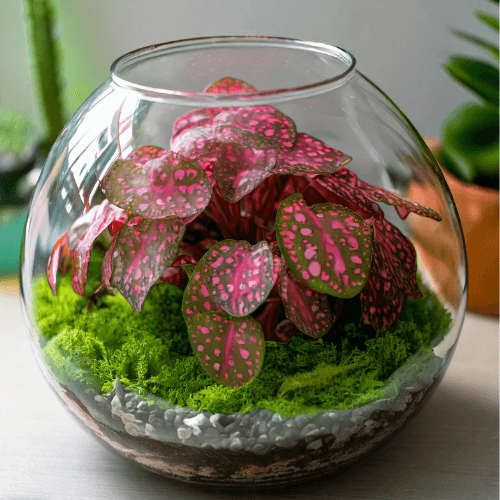Enclosed terrariums are more than just beautiful glass containers filled with greenery. They’re self-sustaining ecosystems that allow you to bring a little piece of nature into your home, creating a tranquil space with minimal effort. However, building and maintaining a thriving closed terrarium starts with the right plants for enclosed terrariums.
In this ultimate guide, you’ll discover everything you need to know about selecting, caring for, and enjoying plants for enclosed terrariums. Whether you’re a beginner or an experienced plant enthusiast, we’ll cover the best plant types, their care requirements, common mistakes to avoid, and much more. Let’s dive into the world of plants for enclosed terrariums and learn how to create a lush, vibrant miniature garden right in your living room.
Table of Contents
What Are Enclosed Terrariums?
Defining Enclosed Terrariums
An enclosed terrarium is essentially a self-sustaining mini ecosystem, housed in a glass container, that requires minimal maintenance. The container is typically sealed, allowing moisture to accumulate inside, creating a humid environment that’s perfect for specific types of plants. These closed environments make it easy to grow tropical plants, mosses, and ferns in a controlled space, with little intervention required once everything is set up.
Why Choose an Enclosed Terrarium?
There are many reasons why you might want to create an enclosed terrarium in your home. Here are just a few:
- Minimal Maintenance: The sealed glass helps maintain humidity levels, reducing the need for constant watering.
- Space-Saving: Perfect for apartments, desks, and small spaces where you want to add greenery but don’t have room for larger plants.
- Decorative: Enclosed terrariums can become beautiful centerpieces or charming additions to any room.
- Easy to Care For: With the right setup and plant choice, a terrarium can thrive for months with very little attention.
What Makes a Good Plant for Enclosed Terrariums?
Choosing the right plants for enclosed terrariums can be a bit tricky if you’re unfamiliar with the specific conditions these glass environments create. Unlike open terrariums, which have more airflow and drier conditions, enclosed terrariums create a humid, low-light environment. This means you’ll need to select plants that thrive under these conditions.
Key Characteristics of Plants Inside a Terrarium
- Humidity Lovers: Most plants for enclosed terrariums thrive in moist conditions. These plants should be able to handle the humidity that builds up inside a sealed glass container.
- Slow Growers: Closed terrariums have limited space, so you want to choose plants that grow slowly and stay compact.
- Shade-Tolerant: Since most enclosed terrariums don’t get direct sunlight, you’ll want plants that do well in low or indirect light.
- Low Maintenance: Look for plants that require minimal attention once they’re established. These plants can survive with little care and still provide lush, vibrant greenery.
Best Types of Terrarium Plants for Enclosed Spaces
When it comes to selecting plants for a terrarium, here are some of the best candidates:
- Tropical Plants: Tropical plants love humidity, making them perfect for enclosed terrariums. They also add vibrant color and texture to your terrarium.
- Ferns: Many ferns, like the Boston fern or maidenhair fern, thrive in the humid, low-light conditions of a closed terrarium.
- Mosses: Moss is a staple in terrariums. It’s easy to care for and perfect for covering the ground of your enclosed terrarium, creating a lush, green base for other plants.
- Miniature Plants: Small, slow-growing plants such as fittonia (nerve plant) or baby tears work well in the compact space of a closed terrarium.
Top 10 Plants for Enclosed Terrariums
If you’re wondering which plants for enclosed terrariums will thrive in your glass ecosystem, here are ten of the best options to consider:
Fittonia (Nerve Plant)

This plant is known for its vibrant, vein-like patterns on its leaves. It thrives in low light and high humidity, making it a perfect choice for your terrarium.
Mosses

Moss is ideal for the bottom layer of a terrarium. It thrives in moist conditions and creates a beautiful, natural look.
Ferns (Boston Fern, Maidenhair Fern)

Ferns do well in humid, low-light environments and can fill out your terrarium with lush greenery. They’re also great for adding texture and volume.
Peperomia

With its unique, waxy leaves and compact size, peperomia is perfect for a closed terrarium. It thrives in high humidity and indirect light.
Calathea

Calathea, known for its bold leaf patterns, thrives in moist, humid environments and can add a stunning contrast to your terrarium.
Polka Dot Plant

This plant features bright, contrasting spots or dashes of color on its leaves, adding a pop of brightness to your closed terrarium.
Miniature Orchids

Orchids are a great way to add a touch of elegance to your terrarium. Choose varieties that thrive in high humidity, such as the Phalaenopsis orchid.
Baby Tears (Soleirolia)

Baby tears create a delicate, cascading effect in your terrarium, making them an excellent ground cover.
Anthurium

With its unique, glossy red flowers, anthuriums bring a tropical flair to any terrarium. They thrive in humid conditions and indirect light.
Pilea

Pilea, also known as the "Chinese money plant," is a trendy plant that works well in a terrarium due to its compact size and easy care requirements.
Comparison Table
| Plant Name | Light Needs | Watering Requirements | Special Notes |
|---|---|---|---|
| Fittonia | Low to medium light | Moderate | Keep away from direct sunlight. |
| Mosses | Low light | High humidity | Always keep moist. |
| Maidenhair Fern | Indirect light | Regular misting | Avoid dry air. |
| Peperomia | Low light | Moderate | Excellent for small spaces. |
| Calathea | Low to medium light | Consistent moisture | Needs high humidity. |
Caring for Plants Inside a Terrarium
Once you’ve selected your plants for enclosed terrariums, it’s time to focus on care. The beauty of a terrarium lies in its ability to thrive with minimal attention, but you still need to ensure the right conditions for your plants to flourish.
Maintaining the Right Environment
Closed terrariums maintain their own water cycle, but you still need to create the right conditions for growth. Here are a few tips:
- Light: Ensure your terrarium receives bright, indirect light. Avoid placing it in direct sunlight, as this can overheat the plants inside the glass.
- Temperature: Enclosed terrariums tend to stay warm due to the humidity inside the container. Aim for a temperature between 65-75°F (18-24°C).
- Ventilation: While the sealed environment helps retain moisture, it’s essential to open the terrarium occasionally to let fresh air circulate and prevent mold buildup.
Watering Closed Terrarium Plants
One of the biggest advantages of a closed terrarium is that it requires minimal watering. The water cycle inside the sealed container allows moisture to evaporate, then condense on the glass and drip back down to the soil. Here’s how to ensure your plants inside a terrarium don’t get overwatered:
- Check for Condensation: If you notice heavy condensation on the glass, your terrarium has enough moisture.
- Misting: Use a spray bottle to lightly mist the plants, especially if the terrarium looks dry.
- Avoid Overwatering: Too much water can lead to mold growth or plant rot.
Troubleshooting Common Issues with Plants for Enclosed Terrariums
Even with proper care, you may encounter a few challenges with your plants for enclosed terrariums. Here’s how to address common issues:
- Overgrowth: If your plants are growing too quickly for the space, prune them back regularly to prevent overcrowding.
- Mold Growth: If mold starts to appear, remove it carefully, and increase ventilation. You may also add a small layer of activated charcoal to prevent further mold growth.
- Yellowing Leaves: Yellow leaves usually indicate overwatering or insufficient light. Adjust the watering schedule or move the terrarium to a brighter location.
DIY Guide: Building Your Enclosed Terrarium
Creating your own enclosed terrarium is easier than you think! Follow these steps to design a beautiful, self-sustaining ecosystem in a glass container:
Materials Needed
- A glass container with a lid (you can use jars, fish tanks, or even vases)
- Pebbles for drainage
- Activated charcoal (to keep the soil fresh)
- Potting soil (ideal for tropical plants)
- Your choice of plants for enclosed terrariums
Step-by-Step Instructions (Continued)
- Create a Drainage Layer
Begin by adding a layer of small pebbles or gravel to the bottom of your container. This layer helps excess water drain away from the soil, preventing waterlogging and root rot. - Add Activated Charcoal
Sprinkle a thin layer of activated charcoal on top of the pebbles. This helps absorb odors and toxins, keeping your terrarium fresh and healthy. - Layer with Moss
Add a layer of moss over the charcoal. This acts as a barrier to prevent the soil from sinking into the drainage layer, keeping the design neat and functional. - Add Potting Soil
Spread a layer of potting soil that is appropriate for tropical plants. The depth depends on the size of your terrarium, but ensure it’s deep enough to accommodate the root systems of your chosen plants. - Arrange Your Plants
Choose a variety of terrarium plants that complement each other in size, color, and growth patterns. Arrange taller plants in the back (or center for round containers) and smaller ones toward the front. Leave space between plants for growth and airflow. - Water Lightly
Use a spray bottle to lightly mist the soil and plants. Avoid overwatering, as the enclosed terrarium will retain moisture naturally. - Seal and Position
Close the lid and place your terrarium in a location with bright, indirect light. Avoid direct sunlight, as it can overheat the interior.
Frequently Asked Questions About Plants for Enclosed Terrariums
Q: What plants are best for beginners?
A: For beginners, start with low-maintenance plants like moss, ferns, and fittonia. These are resilient and thrive in enclosed, humid environments.
Q: How often should I water my enclosed terrarium?
A: Typically, a closed terrarium rarely needs additional watering. Monitor condensation on the glass—if there’s no moisture, lightly mist the soil.
Q: Can I use succulents in an enclosed terrarium?
A: No, succulents are better suited for open terrariums because they prefer dry conditions. High humidity in an enclosed terrarium can cause succulents to rot.
Q: How do I prevent mold in my terrarium?
A: To prevent mold, ensure your terrarium has proper drainage and use activated charcoal. Open the lid occasionally for ventilation.
Q: What’s the best way to prune overgrown plants?
A: Use small scissors to trim overgrown or yellowing leaves. Regular pruning prevents overcrowding and keeps your terrarium looking its best.
Conclusion
Enclosed terrariums offer a unique way to bring the beauty of nature into your home with minimal maintenance. By selecting the right plants for enclosed terrariums, creating the perfect setup, and following a simple care routine, you can enjoy a lush, thriving ecosystem in a glass container.
Whether you’re a beginner or an experienced plant enthusiast, crafting a terrarium is a creative and rewarding project that brings endless enjoyment. The key is to start with the right materials, choose humidity-loving plants, and maintain a balanced environment.
So, why wait? Gather your supplies, pick your favorite plants, and start building your enclosed terrarium today. Your miniature rainforest is just a few steps away!
Call-to-Action: Have you tried building an enclosed terrarium? Share your creations and tips with us on social media! Let’s inspire others to embrace the magic of plants for enclosed terrariums.

